News
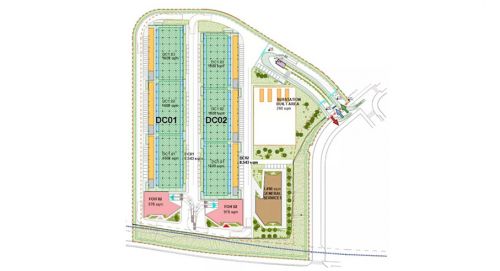
13/04/2023
Panattoni acquires 60,000 sqm land plot to build a data center
Panattoni acquires 60,000 sqm land plot to build a data center
Panattoni has formalises the purchase of a 60,000 sqm land plot in Parc de l'Alba (BSP) to develop a new hyperscale data center for €30.6 million. The total estimated investment for this project is €300 million, which will be implemented in different stages. The construction of the first stage will begin at the end of 2023, and it will have a total floor area of 42,000 sqm. The total allocated electrical power of the plot is 42 MW, although Panattoni plans to increase this figure in the future with a new electrical substation. Link
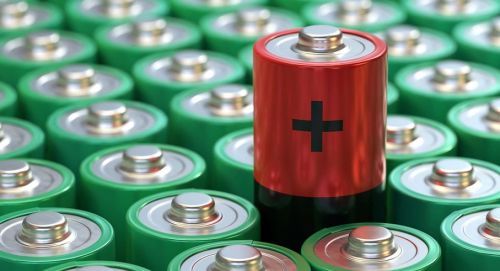
16/09/2021
Battery technology in the Barcelona Synchrotron Park environment
Battery technology in the Barcelona Synchrotron Park environment
Last July, in the framework of electric mobility, one of the current challenges for our society, the Spanish government approved the Strategic Project for the Recovery and Economic Transformation of the Electric and Connected Vehicle, a comprehensive initiative that aims to provide the industrial fabric with all the capabilities and infrastructure needed for the development of the electric car.
In this context, within the Barcelona Synchrotron Park environment, top-level entities are working to promote the research and development of this technology: increasing its performance and sustainability, identifying new chemical molecules beyond lithium ions, etc.
First of all, let’s mention two research institutes located on the campus of our partner and neighbor the Autonomous University of Barcelona, leaders in materials science and among the world centers involved in this field of research: the Institute of Materials Science of Barcelona (ICMAB) and the Catalan Institute of Nanoscience and Nanotechnology (ICN2).
Secondly, let’s highlight the Eurecat technology centre with one of its locations next to our Park. This year, Eurecat has created, together with the Catalonia Institute for Energy Research (IREC), the reference centre on batteries of southern Europe Battech, which will focus its activities on R&D projects. It will cover the cell and battery design, materials, testing and validation, industrialization, second life and circularity stages to generate and transfer knowledge to industry.
Finally, we should mention the Alba Synchrotron, the icon of our park and a facility for cutting-edge research and technological development, which plays a key role in the field of batteries: it allows the characterization and development of new materials, for example for anodes and cathodes, or the analysis of their in-situ behaviour in the charging and discharging processes.
In this context, within the Barcelona Synchrotron Park environment, top-level entities are working to promote the research and development of this technology: increasing its performance and sustainability, identifying new chemical molecules beyond lithium ions, etc.
First of all, let’s mention two research institutes located on the campus of our partner and neighbor the Autonomous University of Barcelona, leaders in materials science and among the world centers involved in this field of research: the Institute of Materials Science of Barcelona (ICMAB) and the Catalan Institute of Nanoscience and Nanotechnology (ICN2).
Secondly, let’s highlight the Eurecat technology centre with one of its locations next to our Park. This year, Eurecat has created, together with the Catalonia Institute for Energy Research (IREC), the reference centre on batteries of southern Europe Battech, which will focus its activities on R&D projects. It will cover the cell and battery design, materials, testing and validation, industrialization, second life and circularity stages to generate and transfer knowledge to industry.
Finally, we should mention the Alba Synchrotron, the icon of our park and a facility for cutting-edge research and technological development, which plays a key role in the field of batteries: it allows the characterization and development of new materials, for example for anodes and cathodes, or the analysis of their in-situ behaviour in the charging and discharging processes.
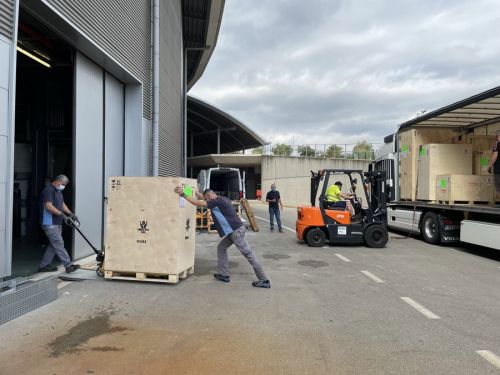
06/09/2021
Advances in the creation of a state-of-the-art microscopy platform at the Alba Synchrotron
Advances in the creation of a state-of-the-art microscopy platform at the Alba Synchrotron
On last August 31, the Alba Synchrotron, the icon of our Park, received the Glacios high-voltage transmission cryo-electron microscope (Cryo-TEM, 200 kV) from the Czech Republic. This state-of-the-art equipment will be part of the new advanced microscopy platform located in the Alba Synchrotron itself, which will provide new opportunities to both research groups and companies, and will make Barcelona a hub of excellence in Europe for scientific collaboration in this field.
The new Glacios microscope is intended for biological applications and allows observing the structure of biomolecules at atomic scale without the need to obtain crystals. It is a microscope suitable for biological sample screening and atomic-level structural data acquisition of large molecular and cellular complexes. It may be used, for example, to study the external structure of coronavirus, such as the one responsible for currently COVID-19 pandemic, or the receptors it uses to enter cells. The acquisition is made possible thanks to the joint action of the Molecular Biology Institute of Barcelona (IBMB-CSIC, project head), the Alba Synchrotron, the Institute for Research in Biomedicine of Barcelona (IRB), the Spanish Council for Scientific Research (CSIC), the Centre for Genomic Regulation of Barcelona (CRG), the Autonomous University of Barcelona (UAB) and the Barcelona Institute of Science and Technology (BIST), and the support of ERDF European funds, granted by the Secretariat of University and Research of the Department of Business and Knowledge of the Generalitat de Catalunya.
In addition to Glacios, the platform will also incorporate a monochromated transmission electron microscope with aberration correctors and a sample preparation equipment specially designed for materials science and atomic-scale studies. In this case, the project involves the Catalan Institute of Nanoscience and Nanotechnology (ICN2, project head), the Alba Synchrotron, the Spanish Council for Scientific Research (CSIC), the Institute of Materials Science of Barcelona (ICMAB-CSIC), the Autonomous University of Barcelona (UAB) and the Barcelona Institute of Science and Technology (BIST), and it has also received financial support from ERDF funds.
The new Glacios microscope is intended for biological applications and allows observing the structure of biomolecules at atomic scale without the need to obtain crystals. It is a microscope suitable for biological sample screening and atomic-level structural data acquisition of large molecular and cellular complexes. It may be used, for example, to study the external structure of coronavirus, such as the one responsible for currently COVID-19 pandemic, or the receptors it uses to enter cells. The acquisition is made possible thanks to the joint action of the Molecular Biology Institute of Barcelona (IBMB-CSIC, project head), the Alba Synchrotron, the Institute for Research in Biomedicine of Barcelona (IRB), the Spanish Council for Scientific Research (CSIC), the Centre for Genomic Regulation of Barcelona (CRG), the Autonomous University of Barcelona (UAB) and the Barcelona Institute of Science and Technology (BIST), and the support of ERDF European funds, granted by the Secretariat of University and Research of the Department of Business and Knowledge of the Generalitat de Catalunya.
In addition to Glacios, the platform will also incorporate a monochromated transmission electron microscope with aberration correctors and a sample preparation equipment specially designed for materials science and atomic-scale studies. In this case, the project involves the Catalan Institute of Nanoscience and Nanotechnology (ICN2, project head), the Alba Synchrotron, the Spanish Council for Scientific Research (CSIC), the Institute of Materials Science of Barcelona (ICMAB-CSIC), the Autonomous University of Barcelona (UAB) and the Barcelona Institute of Science and Technology (BIST), and it has also received financial support from ERDF funds.
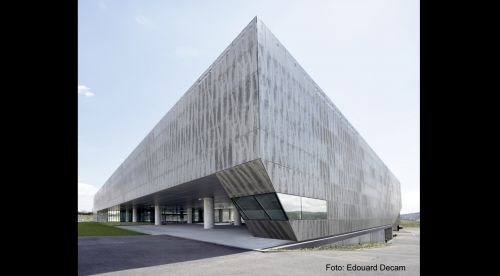
22/07/2021
IBM, the big blue of technology at the Barcelona Synchrotron Park
IBM, the big blue of technology at the Barcelona Synchrotron Park
Due to its infrastructure and location, the Barcelona Synchrotron Park (BSP) is a privileged place to set up data centres: first-level electric infrastructure (high capacity, high reliability, possibility of redundant power supply from cogeneration), top-quality telecommunications infrastructure (7 operators with own networks and different access points), ambient air compatible with free-cooling technologies, minimal risks and minimal energy costs, etc. Currently, the BSP already hosts four operative data centres and offers 42,000 m2 of land specially adapted to house new ones.
In this context, the IBM company —also known as Big Blue—, leader in areas such as artificial intelligence, cloud, quantum computing and security, has an important presence in the BSP. In 2013, the US multinational set up its Cloud Computing Centre in our Park, in a building shared with Silc Immobles, a CaixaBank subsidiary which owns the structure. Both entities benefit from the synergies generated in this facility, since IBM is also a long-standing strategic partner of the financial institution.
The building, Tier III certified by Uptime Institute, is designed by IDOM group’s ACXT Architects and includes over 6,000 m2 of processors distributed over 18 IT rooms, as well as exploitation and parking areas, offices, workshops, etc. The typology required a maximum technological functionality, prioritising flexibility, scalability and energy efficiency, in the three floors with computer rooms as well as in the two technical floors of the building. The challenge of the project was to strike a balance between this functionality and the minimum environmental impact. The application of sustainable design criteria and good practices made it possible to obtain the LEED certification.
In this context, the IBM company —also known as Big Blue—, leader in areas such as artificial intelligence, cloud, quantum computing and security, has an important presence in the BSP. In 2013, the US multinational set up its Cloud Computing Centre in our Park, in a building shared with Silc Immobles, a CaixaBank subsidiary which owns the structure. Both entities benefit from the synergies generated in this facility, since IBM is also a long-standing strategic partner of the financial institution.
The building, Tier III certified by Uptime Institute, is designed by IDOM group’s ACXT Architects and includes over 6,000 m2 of processors distributed over 18 IT rooms, as well as exploitation and parking areas, offices, workshops, etc. The typology required a maximum technological functionality, prioritising flexibility, scalability and energy efficiency, in the three floors with computer rooms as well as in the two technical floors of the building. The challenge of the project was to strike a balance between this functionality and the minimum environmental impact. The application of sustainable design criteria and good practices made it possible to obtain the LEED certification.
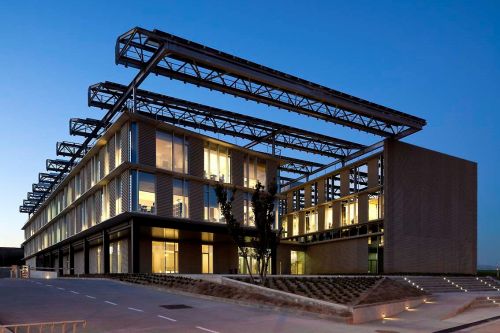
02/07/2021
SENER, cutting-edge engineering and technology in the Barcelona Synchrotron Park
SENER, cutting-edge engineering and technology in the Barcelona Synchrotron Park
The international engineering and technology group SENER, founded 65 years ago, accomplishes Aerospace and Engineering activities. It has a long track record of projects, international experience and a team comprised of thousands of professionals who innovates in four major sectors: Aerospace, Infrastructure, Energy and Marine.
The SENER Catalan headquarters, located in the Barcelona Synchrotron Park, is a sustainable and modern building (photo) designed by its own team of architects, on a 7,500 sqm plot with an above-ground GFA of 16,000 sqm, which houses over 300 professionals from different disciplines, including engineers, mathematicians, physicists and architects.
In this building, SENER Aeroespacial has recently invested over 5 million Euros in new technological facilities for space and astronomy, specifically in new equipment and in white rooms (1,000 sqm); these facilities, which currently employ about 50 people, place SENER Aeroespacial at the forefront in the development and production of electronic radio frequency devices based on gallium nitride (GAN) technology, which is key to future generations of communications satellites. This investment is on top of the 70 million invested in 2018 with the acquisition of the TRYO Aerospace & Electronics group, making a total of 75 million euros invested in the last three years.
SENER Aerospace aspires to become one of the leading European companies in Space and Science. One of the pillars of growth is the telecommunications sector, where it already has a track record of working on more than 1,500 satellites and space vehicles; he is also a European leader in precision mechanical systems for satellite platforms and instruments, having taken part in the main programs of the ESA and NASA space agencies; of note in the area of science are its contributions to ground-based astronomy and large scientific infrastructure (LSI), where it has a wide portfolio of projects and clients, such as the European Southern Observatory (ESO).
Press release (Sener)
The SENER Catalan headquarters, located in the Barcelona Synchrotron Park, is a sustainable and modern building (photo) designed by its own team of architects, on a 7,500 sqm plot with an above-ground GFA of 16,000 sqm, which houses over 300 professionals from different disciplines, including engineers, mathematicians, physicists and architects.
In this building, SENER Aeroespacial has recently invested over 5 million Euros in new technological facilities for space and astronomy, specifically in new equipment and in white rooms (1,000 sqm); these facilities, which currently employ about 50 people, place SENER Aeroespacial at the forefront in the development and production of electronic radio frequency devices based on gallium nitride (GAN) technology, which is key to future generations of communications satellites. This investment is on top of the 70 million invested in 2018 with the acquisition of the TRYO Aerospace & Electronics group, making a total of 75 million euros invested in the last three years.
SENER Aerospace aspires to become one of the leading European companies in Space and Science. One of the pillars of growth is the telecommunications sector, where it already has a track record of working on more than 1,500 satellites and space vehicles; he is also a European leader in precision mechanical systems for satellite platforms and instruments, having taken part in the main programs of the ESA and NASA space agencies; of note in the area of science are its contributions to ground-based astronomy and large scientific infrastructure (LSI), where it has a wide portfolio of projects and clients, such as the European Southern Observatory (ESO).
Press release (Sener)
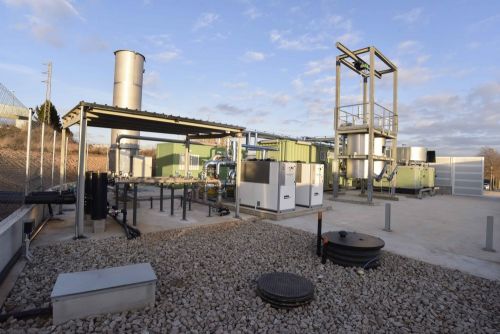
11/06/2021
Parc de l'Alba: first injection of landfill gas into the distribution network
Parc de l'Alba: first injection of landfill gas into the distribution network
In Parc de l’Alba, Naturgy Group and Nedgia recently achieved a pioneering breakthrough in Spain’s energy transition with the first injection of landfill biomethane into the gas distribution network. This new energy vector should make a significant contribution towards decarbonising the country's energy system.
Within the framework of the circular economy, this achievement is an important step forward in a project that aims to take advantage of the biogas produced in an excavation (called Elena and located in the Parc de l'Alba) resulting from a former clay extraction activity, which was used to store waste bales from Barcelona Metropolitan Area waste recovery plants, between 2007 and 2011.
For this purpose, the Elena Renewable Gas Plant was started up earlier this year, a facility that represents an investment of €2.2 million and is composed of an upgrading plant to filter the biogas and collect its methane (called biomethane), and of an injection plant to introduce it into the natural gas grid present in the Park. The upgrading plant uses membrane separation technologies, an upgrading system that consists of the physical separation of CO2 and CH4 molecules based on their different size.
The company points out that this Parc de l'Alba facility will be able to inject 12 GWh/year of biomethane into the gas distribution network, equivalent to the consumption of 3,200 homes with natural gas, and will avoid the emission into the atmosphere of 2,400 tons of CO2/year, equivalent to planting about 5,000 trees.
Within the framework of the circular economy, this achievement is an important step forward in a project that aims to take advantage of the biogas produced in an excavation (called Elena and located in the Parc de l'Alba) resulting from a former clay extraction activity, which was used to store waste bales from Barcelona Metropolitan Area waste recovery plants, between 2007 and 2011.
For this purpose, the Elena Renewable Gas Plant was started up earlier this year, a facility that represents an investment of €2.2 million and is composed of an upgrading plant to filter the biogas and collect its methane (called biomethane), and of an injection plant to introduce it into the natural gas grid present in the Park. The upgrading plant uses membrane separation technologies, an upgrading system that consists of the physical separation of CO2 and CH4 molecules based on their different size.
The company points out that this Parc de l'Alba facility will be able to inject 12 GWh/year of biomethane into the gas distribution network, equivalent to the consumption of 3,200 homes with natural gas, and will avoid the emission into the atmosphere of 2,400 tons of CO2/year, equivalent to planting about 5,000 trees.









